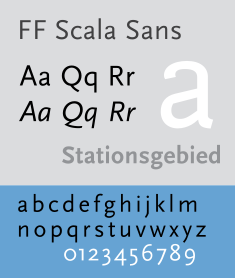 | |
| Category | Sans-serif |
|---|---|
| Classification | Humanist |
| Designer(s) | Martin Majoor |
| Foundry | FontFont |
FF Scala Sans is a humanist sans-serif typeface designed by Dutch designer Martin Majoor in 1993 for the Vredenburg Music Center in Utrecht, the Netherlands. It was designed as a companion to Majoor's earlier serif old style typeface FF Scala, designed in 1990. It is similar in appearance to Joanna Sans.
Contents
Like Eric Gill's 1927–30 design Gill Sans and Hans Eduard Meier's typeface Syntax, both upper and lower case are structurally modeled on serif old style faces. The lowercase roman a and g are two-story. FF Scala Sans' italics are true italics, not sloped roman. The lowercase a, e, v and y are particularly calligraphic. FF Scala Sans is a very complete sans-serif in its inclusion of true small capitals, lining and non-lining (old style figures) and many ligatures. In 1993, an additional condensed width of the typeface was released. The typefaces are available through Font Shop International. In 2023, the font, alongside its companion FF Scala, were reissued as "Scala Sans" and "Scala", respectively on Majoor's own independent type foundry, which was founded in 2021.
